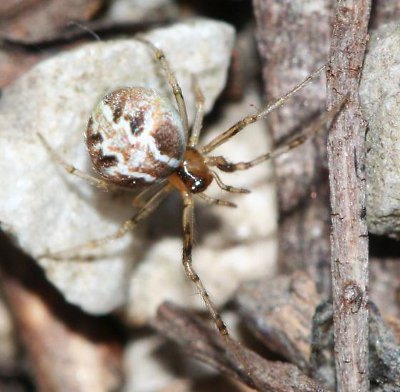Theridiid Spider
Category: Arachnida Spider

Facts about Theridiid Spider, Therdion Spider named after the Theridiidae family in which it belongs. This gene of spider consists of about 600 described species. And the Notable species is the Hawaiian happy face spider. It is categorized as a cobweb spider, and chances are that you can not miss to notice a cobweb spider in a corner somewhere in your house at this right moment. The Theridiid Spider are also commonly known as the comb-foot spiders.
Physical Description of Theridiid Spiders
The Therdion Spider has a row of bristles or setae on their legs. This bristles helps the spider to wrap its silk round the captured prey.
The Theridiid Spider are sexually dimorphic in size; the male Therdion Spider is quite smaller than their female counterparts. The female spiders have spherical abdomens and with long slender legs.
Behavior of Theridiid Spiders
Therdion Spider behaves similarly to the Dew Drop Spiders. It builds a web which is used to trap small insects. They live in social community where the adult females share a web with the spider lings. They can also practice kleptoparasitism; the behavior of stealing food from another spiders’ webs.
They build an irregular, and 3 dimensional web of sticky silk. Some of the species are too small and are mild to have any life threatening situation on humans. They are not known to bite people.
They can also work as a team when pulling large prey back to the lair, and they do this in-turn this shows the high coordination that they have.
Diet of Theridiid Spiders
Therdion Spider feed on insects that often get trapped on their web. When a prey gets trapped on the spider’s web, immediately the spider will inject it with venom and then wrap it tightly in its silk. This way the meal can be consumed later.
Habitat of Theridiid Spiders
Therdion Spider is quite common in relatively damp terrain, in the herbaceous and the bush layer. It also likes sharing webs with the large orb weavers.
Theridiid Spiders have oversize brains.
In the Theridiid Spider the oxygen is bound to "hemocyanin" a copper-based protein that turns their blood blue, a molecule that contains copper rather than iron. Iron-based hemoglobin in red blood cells turns the blood red
Theridiid Spiders have two body parts, the front part of the body is called the Cephalothorax-(the thorax and fused head of spiders). Also on this part of the body is the Theridiid Spider’s gland that makes the poison and the stomach, fangs, mouth, legs, eyes and brain. Theridiid Spiders also have these tiny little leg-type things called (pedipalps) that are next to the fangs. They are used to hold food while the spider bites it. The next part of the Theridiid Spiders body is the abdomen and the abdomens back end is where there is the spinnerets and where the silk producing glands are located.
The muscles in a Theridiid Spiders legs pull them inward, but the spider can't extend its legs outward. It will pump a watery liquid into its legs that pushes them out. A Theridiid Spider’s legs and body are covered with lots of hair and these hairs are water-repellent, which trap a thin layer of air around the body so the Theridiid Spiders body doesn't get wet. It allows them to float, this is how some spiders can survive under water for hours. A Theridiid Spider feels its prey with chemo sensitive hairs on its legs and than feels if the prey is edible. The leg hair picks up smells and vibrations from the air. There are at minimum, two small claws that are at the end of the legs. Each Theridiid Spiders leg has six joints, giving the Theridiid Spider 48 leg joints. The spider’s body has oil on it, so the spider doesn't stick to it’s own web.
A Theridiid Spiders stomach can only take liquids, so a spider needs to liquefy their food before they eat. They bite on their prey and empty its stomach liquids into the pray which turns it into a soup for them to drink.
A male Theridiid Spider has two appendages called "pedipalps" a sensory organ, instead of a penis, which is filled with sperm and insert by the male into the female Theridiid Spider’s reproductive opening.
Spiders do not have a skeletons. They have a hard outer shell called an exoskeleton-(a rigid external covering for the body in some invertebrate animals). The exoskeleton is hard, so it can’t grow with the spider. The young Theridiid Spiders need to shed their exoskeleton. The spider has to climb out of the old shell through the cephalothorax. Once out, they must spread themselves out before the new exoskeleton will harden. Know they have some room to grow. They stop growing once they fill this shell.
Female Theridiid Spiders lay eggs on a bed of silk, which she creates right after mating. Once the female Theridiid Spider lays her eggs, she will than cover them with more silk.
Spiders belong to a group of animals called "arachnids", mites and Scorpions and a tick is also in the arachnid family. An Arachnids is a creature with eight legs, two body parts, no antennae or wings and are not able to chew on food. Spiders are not insects because insects have three main body parts and six legs and most insects have wings.
The Arachnids are even in a larger group of animals called "arthropods" an invertebrate animal of the large phylum Arthropoda, which also include spiders, crustaceans and insects. They are the largest group in the animal world, about 80% of all animals come from this group. There are over a million different species. There are more than 40,000 different types of spiders in the world.

 Back To Category Arachnida Spider
Back To Category Arachnida Spider